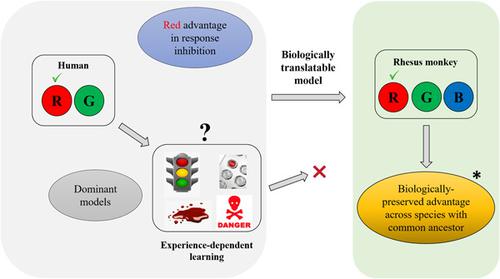当前位置:
X-MOL 学术
›
Am. J. Primatol.
›
论文详情
Our official English website, www.x-mol.net, welcomes your
feedback! (Note: you will need to create a separate account there.)
Color‐hierarchies in executive control of monkeys' behavior
American Journal of Primatology ( IF 2.0 ) Pub Date : 2021-01-05 , DOI: 10.1002/ajp.23231 Sadegh Ghasemian 1, 2 , Marzieh M Vardanjani 1, 2 , Vahid Sheibani 1, 2 , Farshad A Mansouri 3
American Journal of Primatology ( IF 2.0 ) Pub Date : 2021-01-05 , DOI: 10.1002/ajp.23231 Sadegh Ghasemian 1, 2 , Marzieh M Vardanjani 1, 2 , Vahid Sheibani 1, 2 , Farshad A Mansouri 3
Affiliation

|
Processing advantages for particular colors (color‐hierarchies) influence emotional regulation and cognitive functions in humans and manifest as an advantage of the red color, compared with the green color, in triggering response inhibition but not in response execution. It remains unknown how such color‐hierarchies emerge in human cognition and whether they are the unique properties of human brain with advanced trichromatic vision. Dominant models propose that color‐hierarchies are formed as experience‐dependent learning that associates various colors with different human‐made conventions and concepts (e.g., traffic lights). We hypothesized that if color‐hierarchies modulate cognitive functions in trichromatic nonhuman primates, it would indicate a preserved neurobiological basis for such color‐hierarchies. We trained six macaque monkeys to perform cognitive tasks that required behavioral control based on colored cues. Color‐hierarchies significantly influenced monkeys' behavior and appeared as an advantage of the red color, compared to the green, in triggering response inhibition but not response execution. For all monkeys, the order of color‐hierarchies, in response inhibition and also execution, was similar to that in humans. In addition, the cognitive effects of color‐hierarchies were not limited to the trial in which the colored cues were encountered but also persisted in the following trials in which there was no colored cue on the visual scene. These findings suggest that color‐hierarchies are not resulting from association of colors with human‐made conventions and that simple processing advantage in retina or early visual pathways does not explain the cognitive effects of color‐hierarchies. The discovery of color‐hierarchies in cognitive repertoire of monkeys indicates that although the evolution of humans and monkeys diverged in about 25 million years ago, the color‐hierarchies are evolutionary preserved, with the same order, in trichromatic primates and exert overarching effects on the executive control of behavior.
中文翻译:

色阶控制猴子的行为
特定颜色(层次结构)的处理优势会影响人类的情绪调节和认知功能,与绿色相比,红色表现出的优势是与绿色相比,在触发响应抑制方面而不是响应执行方面。尚不清楚这种颜色层次结构如何在人类认知中出现,以及它们是否是具有高级三色视觉的人脑的独特属性。主导模型建议将颜色层次结构形成为依赖于经验的学习,该学习将各种颜色与不同的人工惯例和概念(例如,交通信号灯)相关联。我们假设,如果颜色等级调节了三色非人类灵长类动物的认知功能,则将表明此类颜色等级的神经生物学基础得以保留。我们训练了六只猕猴来执行认知任务,这些任务需要基于彩色提示进行行为控制。颜色层次显着影响猴子的行为,与绿色相比,颜色层次显示为红色的优势,它可以触发响应抑制,但不会触发响应执行。对于所有猴子,在响应抑制和执行方面,颜色等级的顺序与人类相似。此外,颜色等级的认知作用不仅限于遇到彩色提示的试验,而且在随后的视觉场景中没有彩色提示的试验中仍然存在。这些发现表明,颜色等级不是由颜色与人为的惯例相关联造成的,视网膜或早期视觉通路中简单的加工优势并不能解释颜色等级的认知作用。在猴子的认知谱图中发现了颜色层次结构,这表明,尽管人类和猴子的进化在大约2500万年前就出现了分歧,但颜色层次结构却以相同顺序保留在三色灵长类动物中,并对其进化产生了总体影响。执行控制行为。
更新日期:2021-02-01
中文翻译:

色阶控制猴子的行为
特定颜色(层次结构)的处理优势会影响人类的情绪调节和认知功能,与绿色相比,红色表现出的优势是与绿色相比,在触发响应抑制方面而不是响应执行方面。尚不清楚这种颜色层次结构如何在人类认知中出现,以及它们是否是具有高级三色视觉的人脑的独特属性。主导模型建议将颜色层次结构形成为依赖于经验的学习,该学习将各种颜色与不同的人工惯例和概念(例如,交通信号灯)相关联。我们假设,如果颜色等级调节了三色非人类灵长类动物的认知功能,则将表明此类颜色等级的神经生物学基础得以保留。我们训练了六只猕猴来执行认知任务,这些任务需要基于彩色提示进行行为控制。颜色层次显着影响猴子的行为,与绿色相比,颜色层次显示为红色的优势,它可以触发响应抑制,但不会触发响应执行。对于所有猴子,在响应抑制和执行方面,颜色等级的顺序与人类相似。此外,颜色等级的认知作用不仅限于遇到彩色提示的试验,而且在随后的视觉场景中没有彩色提示的试验中仍然存在。这些发现表明,颜色等级不是由颜色与人为的惯例相关联造成的,视网膜或早期视觉通路中简单的加工优势并不能解释颜色等级的认知作用。在猴子的认知谱图中发现了颜色层次结构,这表明,尽管人类和猴子的进化在大约2500万年前就出现了分歧,但颜色层次结构却以相同顺序保留在三色灵长类动物中,并对其进化产生了总体影响。执行控制行为。











































 京公网安备 11010802027423号
京公网安备 11010802027423号